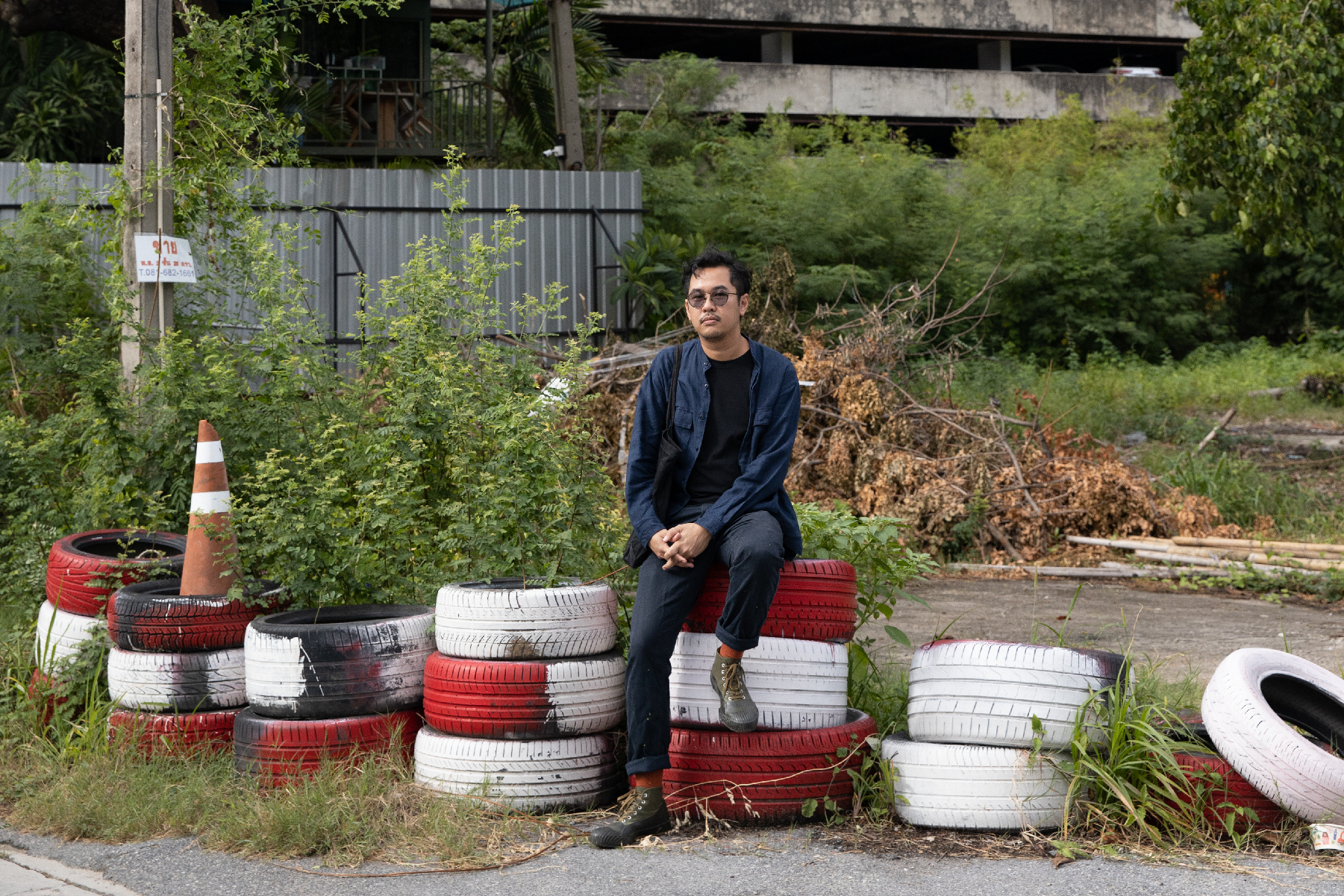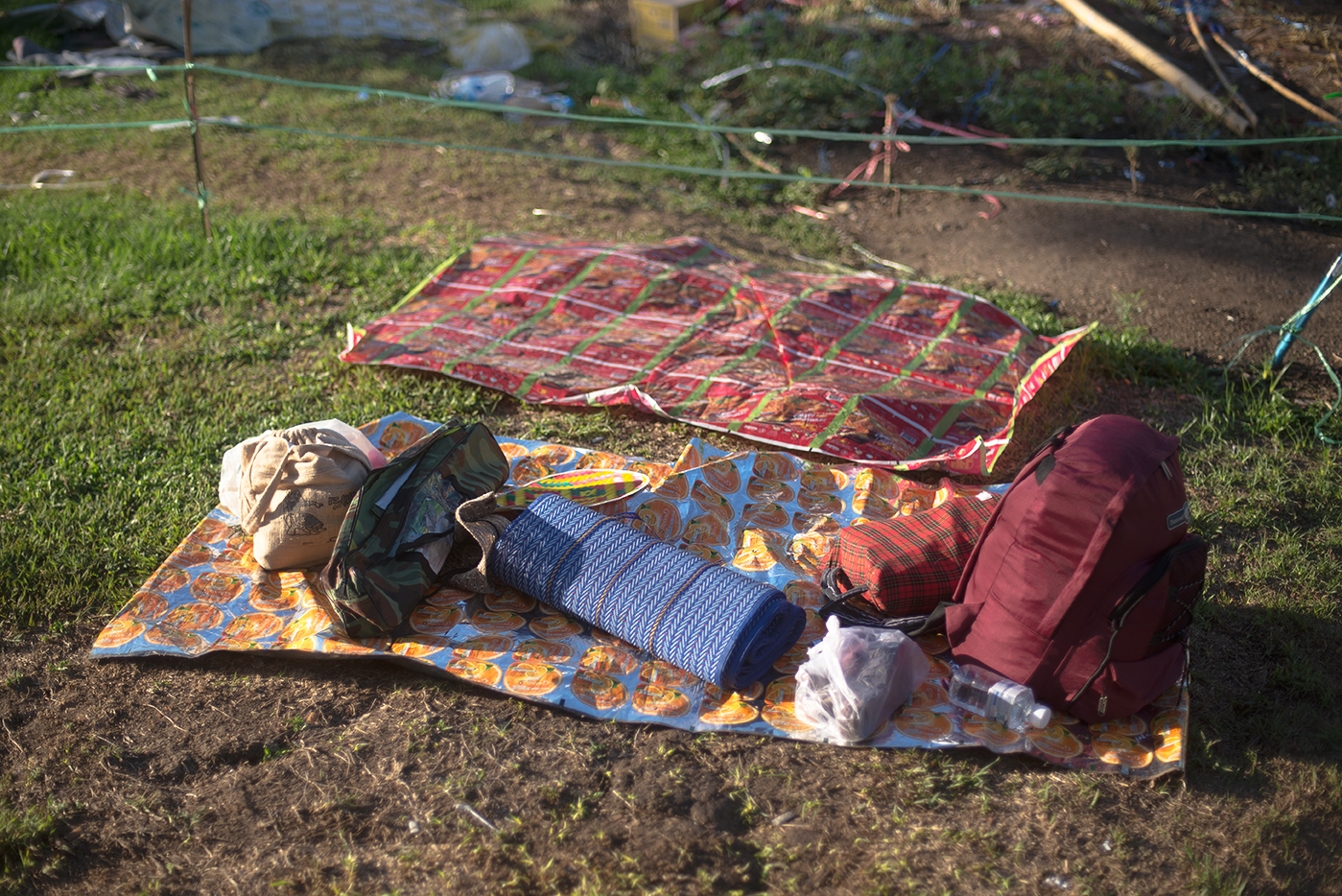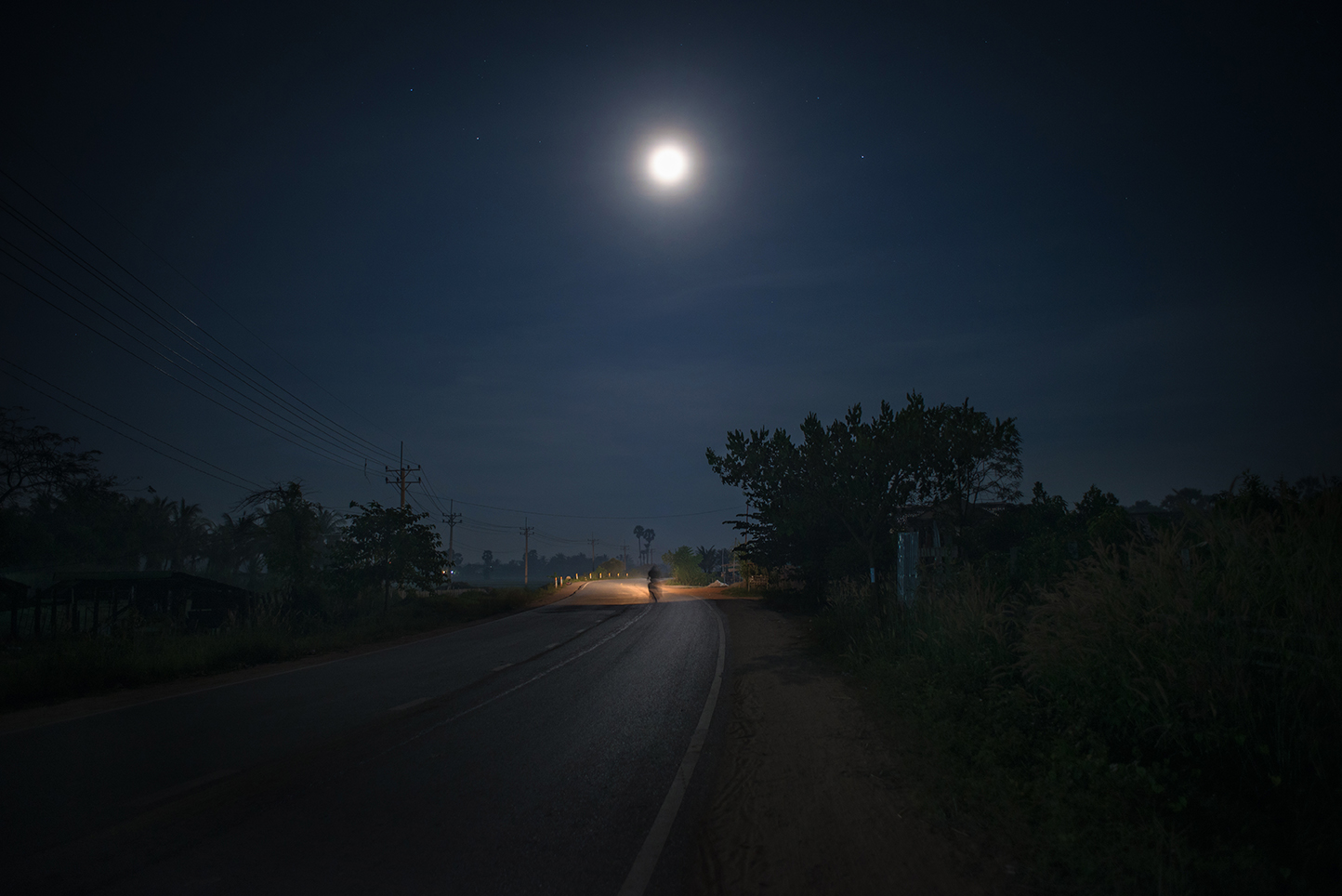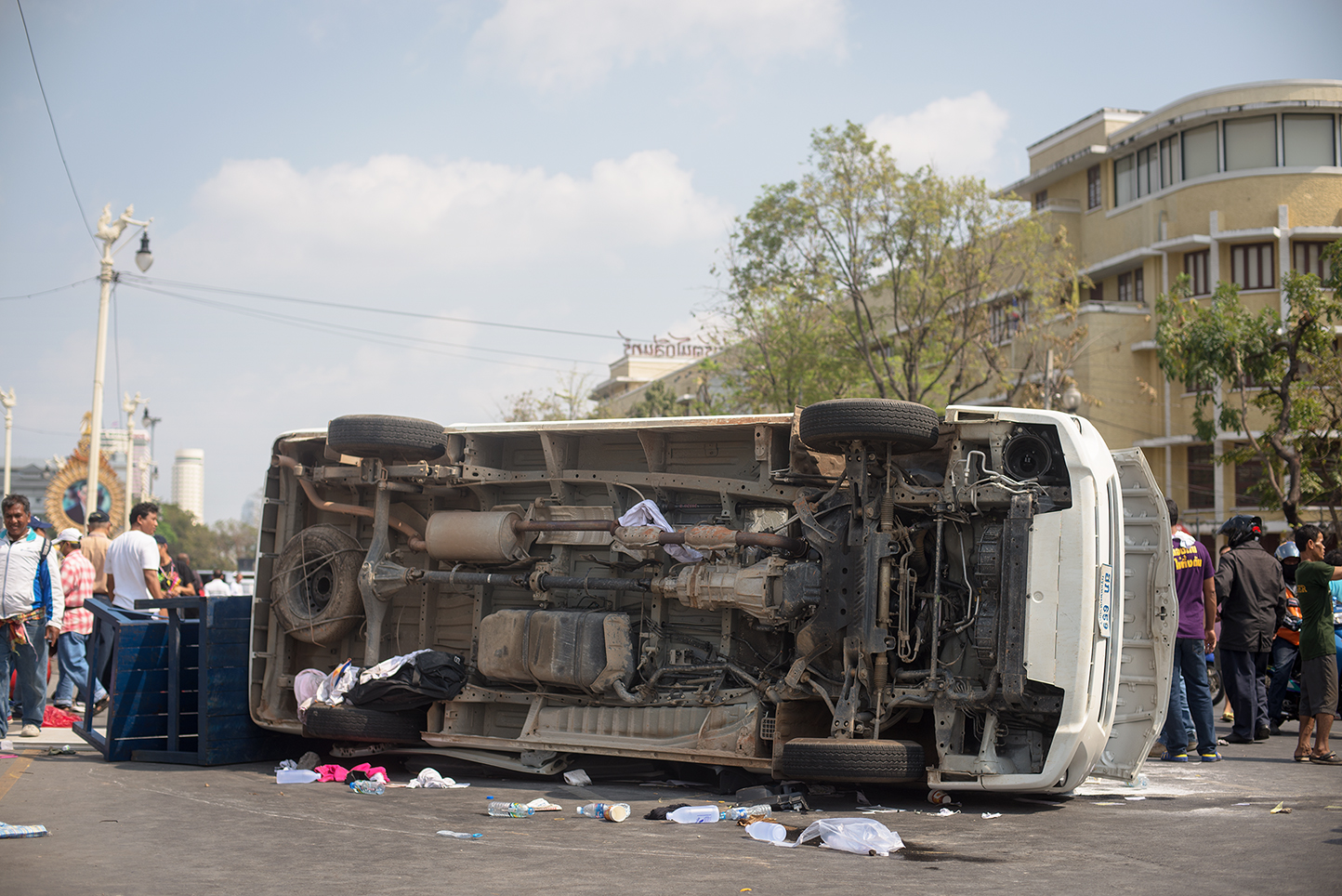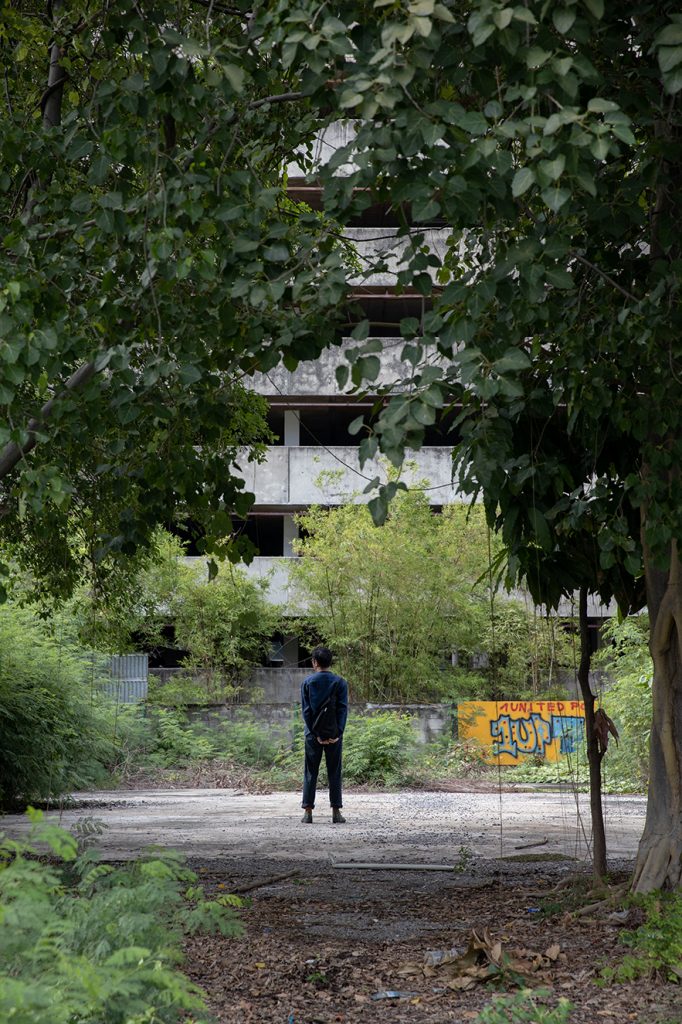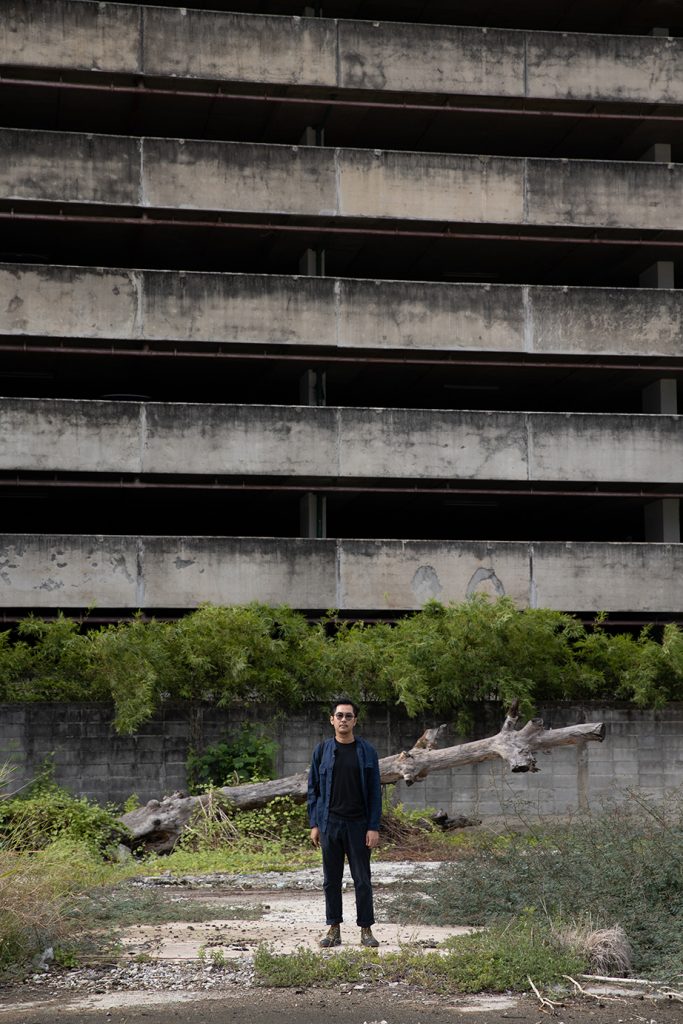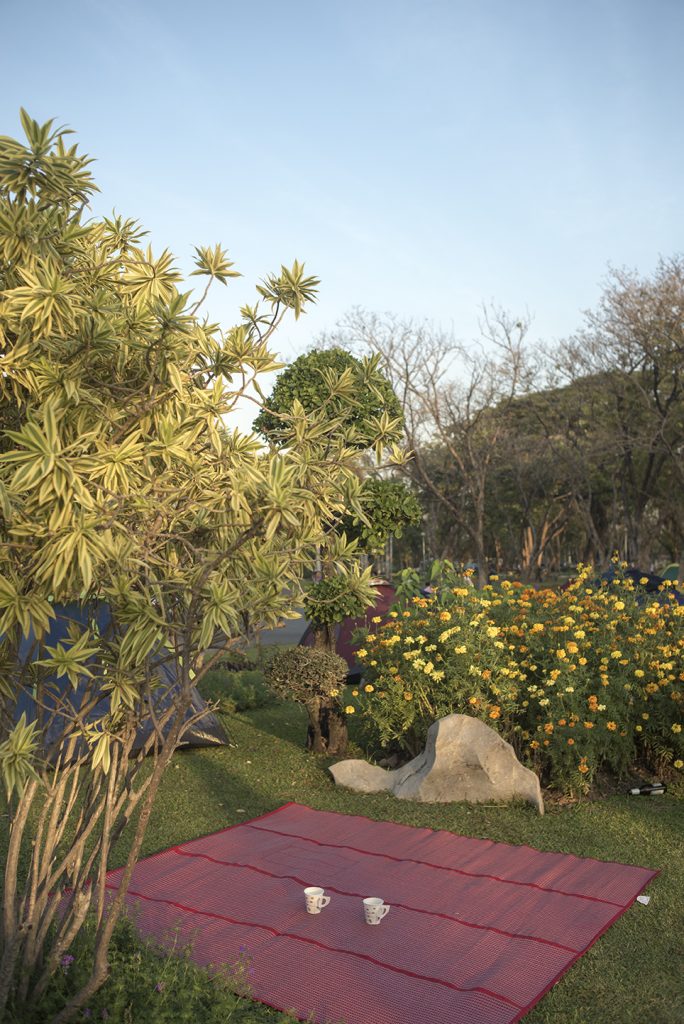ARTIST, FILM LOCATION MANAGER, BOOKSHOP OWNER, THESE ARE THE ROLES THAT WITHIT CHANTHAMARIT IS CURRENTLY TAKING ON
TEXT: NAPAT CHARITBUTRA
PORTRAIT: KETSIREE WONGWAN
PHOTO COURTESY OF THE ARTIST
(For English, please scroll down)
วิทิต จันทามฤต เกิดในครอบครัวข้าราชการเต็มขั้น เขาใช้ชีวิตแบบนักเรียนมัธยมปลายหัวดีที่พอถึงชั้นมัธยมปลายต้องสอบเข้าโรงเรียนเตรียมอุดมศึกษา อย่างไรก็ดี กลุ่มเพื่อนที่คบตอนเป็นนักเรียนเตรียมอุดมฯ ก็ทำให้เขาได้ก้าวเข้ามาสู่โลกของคนทำงานศิลปะ
“เพื่อนกลุ่มที่เราสนิทเขาทำหนังสั้นกัน เราเป็นเด็กกิจกรรมที่ GPA ไม่ค่อยดี ก็เลยยื่นพอร์ตกราฟิกดีไซน์ตามเพื่อนไป สุดท้ายก็ติดมหาวิทยาลัยกรุงเทพกันทั้งกลุ่ม เราติดคณะนิเทศน์ เอกโฆษณา” วิทิตได้ทุนเรียนฟรี 4 ปี แถมด้วยเงินเดือนทุกเดือน ซึ่งทำให้เขาตัดสินใจได้ไม่ยากเพราะจะเป็นการแบ่งเบาภาระที่บ้านไปในตัว “ตอนนั้นเพื่อนๆ ชัดเจนในตัวเองมากกว่าเรา มันดูหนังพี่เจ้ย (อภิชาติพงศ์ วีระเศรษฐกุล) กันตั้งแต่ ม.ปลาย แต่เรายังดู Harry Potter อยู่เลยครับ เราชอบพวกหนังสือภาพ ก็เลยเปิด อ.ส.ท ดูรูปแล้วก็คิดว่า ดีจังเลย เป็นช่างภาพน่าจะได้เดินทางไปหลายๆ ที่”
แต่คำว่า “ถ่ายรูป” สำหรับวิทิตตอนนั้นไม่ใกล้เคียงกับการทำงานศิลปะ (หรือการออกไปข้างนอก) แม้แต่น้อย เขาเล่าว่าตอนนั้นมันคือการทำงานแบบสตูดิโอ ยกของ เซ็ตไฟ จัดแสง วันๆ ได้ยินแต่เสียงปิ๊ปๆ ของแฟลช เขาใช้เวลาปิดเทอมครั้งสุดท้ายตอนเรียนมหาลัยกับการเป็นผู้ช่วยช่างภาพ กระทั่งจบมาหนึ่งปีก็ยังคงช่วยงานสตูดิโอ ได้ค่าจ้างเป็นงานๆ และเลี้ยงชีพตัวเองด้วยการเป็นช่างกล้องรับปริญญา
ถึงจุดๆ หนึ่งวิทิตก็เลิกทำงานสตูดิโอ (มีช่วงหนึ่งผันตัวไปเป็น project manager ด้วย) จุดเปลี่ยนสำคัญคือ น้ำท่วมกรุงเทพฯ ปี 2011 “เราเริ่มรู้สึกว่าที่ผ่านมาเราไม่ได้ออกไปไหนเลย พอดีตอนนั้นงานแคนเซิลหมดเพราะน้ำท่วม เราก็เผอิญไปเจอพี่มิติ (มิติ เรืองกฤตยา) จริงๆ เราเจอพี่เขาใน flickr กับแก๊งที่ออกไปถ่ายรูปน้ำท่วมตอนกลางคืนก็เลยได้จับกล้องออกไปถ่ายรูปกับเขาด้วย”
วิทิตถ่ายภาพบ้านตัวเองหลังจากน้ำลด (Goin Home, 2011) และเป็นตอนนั้นเองที่เขาเริ่มรู้ว่าภาพถ่ายไม่จำเป็นต้องอิงอยู่กับ commercial อย่างเดียว พอน้ำลงออฟฟิศก็เรียกเขากลับไปช่วยงานถ่ายอีกครั้ง (เป็น ad ช่วยเหลือผู้ประสบภัยน้ำท่วม) เขารับงานนั้นเป็นงานสุดท้ายก่อนจะผันตัวเองไปทางศิลปะ ไปร่วม Toom Fab กิจกรรมศิลปินในพำนักที่หนองคายกับกลุ่มศิลปินและคิวเรเตอร์ “ตอนนั้นเราแทบไม่มี artistic process เลย พี่ๆ เขาก็บอกเราว่าให้ลองเล่าสิ่งที่รู้สึกดู แต่พอกลับมาเราก็ไปเป็นช่างภาพเบื้องหลังให้กับหนังเรื่อง 36 ของพี่เต๋อ (นวพล ธำรงรัตนฤทธิ์) เท่ากับว่า ในตัวเราเองตอนนั้นยืนอยู่ทั้งฝั่งหนังและฝั่งศิลปะไปพร้อมๆ กัน” วิทิตบอกกับ art4d
“Angkor Photo Festival เป็นจุดเปลี่ยนที่ตบเราให้เข้ารูปเข้ารอยว่าการถ่ายภาพคืออะไร จำได้ว่าเรานั่งงงอยู่ในคลาสจนถึงสามทุ่ม จนมีคนบอกกับเราว่า นั่งอยู่กับที่ก็ไม่ได้อะไรหรอก ออกไปถ่ายรูปซะ แล้วพรุ่งนี้ค่อยมาคุยกัน เราก็เลยออกไปถ่ายรูปในเสียมเรียบ” การออกไปถ่ายรูปครั้งนั้นเป็นที่มาของผลงานชุด The wanderer (2012) และการพูดคุยในวันต่อๆ มาก็ทำให้วิทิตเข้าใจตัวเองมากขึ้นว่าที่ผ่านมาเขาไม่เคยพาตัวเองออกไปข้างนอกเลย เขาอาศัยอยู่ในกรุงเทพฯ ย่านหลักสี่ที่เดินไปไหนมาไหนไม่ค่อยได้ ตอนเด็กๆ กลับบ้านมาแล้วก็ไม่ออกไปไหน พ่อไม่ให้ออกจากบ้านเพราะกลัวจะโดนปล้น “เรารู้สึกว่าภาพถ่ายมันพาเราออกไปข้างนอกมากขึ้น”
“กลับมาเราเลยใช้เวลานอกบ้านมากขึ้น ที่จำได้ดีคือเราออกไปสังเกตการณ์การล้มเลือกตั้งของม็อบ กปปส. ที่หลักสี่ คือบรรยากาศมันน่ากลัวมาก เราเห็นเหตุการณ์ทั้งหมดว่าใครเริ่มสร้างสถานการณ์ก่อน” วิทิตส่งผลงานชุด Transplantation (2014) สมัครไป Noorderlicht Photofestival ที่เนเธอร์แลนด์ เป็นภาพถ่าย (กึ่ง) เชิงสารคดี บันทึกการใช้ชีวิตของผู้ชุมนุมตามพื้นที่สาธารณะในเมือง โดยตั้งคำถามว่าหรือว่าภาพที่ absurd สุดๆ ที่เห็นนี้ (เช่นภาพบังเกอร์ที่ตั้งอยู่หน้า McDonald) กำลังจะกลายพันธุ์ไปเป็นเรื่องปกติธรรมดาในชีวิตประจำวันของคนไทยในอนาคต
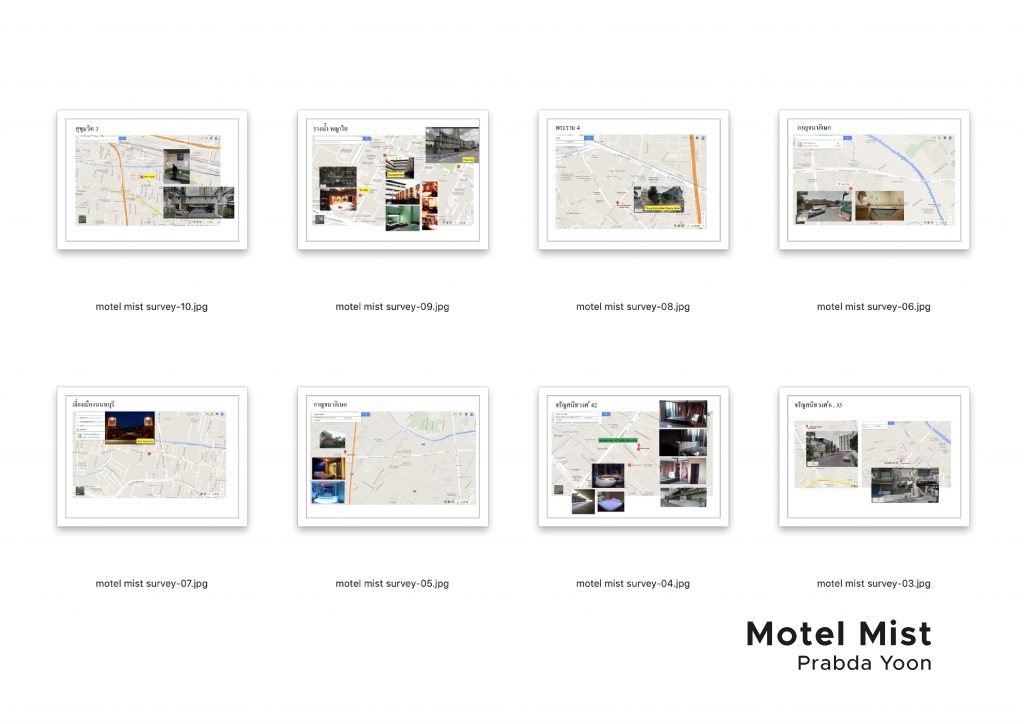
ที่วิทิตกล่าวว่าเขายืนอยู่ทั้งฝั่งหนังและศิลปะไปพร้อมกันในย่อหน้าก่อนนั้น เกิดจากเหตุผลและความจำเป็นด้านการใช้ชีวิตล้วนๆ เพราะการทำงานศิลปะแต่ละทีจำเป็นต้องใช้ทุนไม่น้อย ชีวิตอีกด้านของวิทิตคือการเป็นคนที่ทำงานอยู่เบื้องหลังหรือส่วนที่เป็นกระบวนการของการทำภาพยนตร์ เริ่มต้นจากการเป็นช่างภาพเบื้องหลัง (still photographer) เป็นตากล้องสารคดีเรื่อง ‘สายน้ำติดเชื้อ’ ของ นททวัฒน์ นำเบญจพล ในปี 2013 พอปี 2015 เขาก็กระโดดมาเป็น location manager ให้กับหนังของ ปราบดา หยุ่น เรื่อง ‘Motel Mist’ (2016)
“พี่เขาบอกว่าเราน่าจะทำ location ได้ เพราะเรามองเห็นซีนและมีสกิลในการบริหาร” การทำงานด้าน project management ในโรงถ่ายคงมีประโยชน์ขึ้นมาในตอนนี้เอง วิทิตบอกกับ art4d ว่า หนังเรื่องแรกก็ต้องตามหาโรงแรมม่านรูดเลย ซึ่งมันก็ยากเพราะเขาไม่มีประสบการณ์ วิทิตเริ่มจากการเสิร์ชไปตามเว็บบอร์ดต่างๆ จนไปเจอลิสต์โรงแรมม่านรูดทั้งกรุงเทพฯ “วิธีการเข้าไปก็ต้องอาศัยมุกแบบ น้องชายจะแต่งงาน อยากจะจัดปาร์ตี้ ขอดูสเปซหน่อยได้ไหมครับ?” หรืออีกวิธีคือไปกับทีมงานอีกคนที่เป็นผู้หญิงแล้วก็หลอกเขาว่าขอดูห้องหน่อย ในที่สุดเขาก็ไปเจอโรงแรมม่านรูดชานเมืองขนาดใหญ่ (มีประมาณ 100 ห้อง) “เราก็เลยขอเขาเช่า 2 ชั้นเพื่อถ่ายหนัง สัญญาว่าเราจะไม่กวนแขกที่มาพัก ซึ่งเขาก็ตกลง”
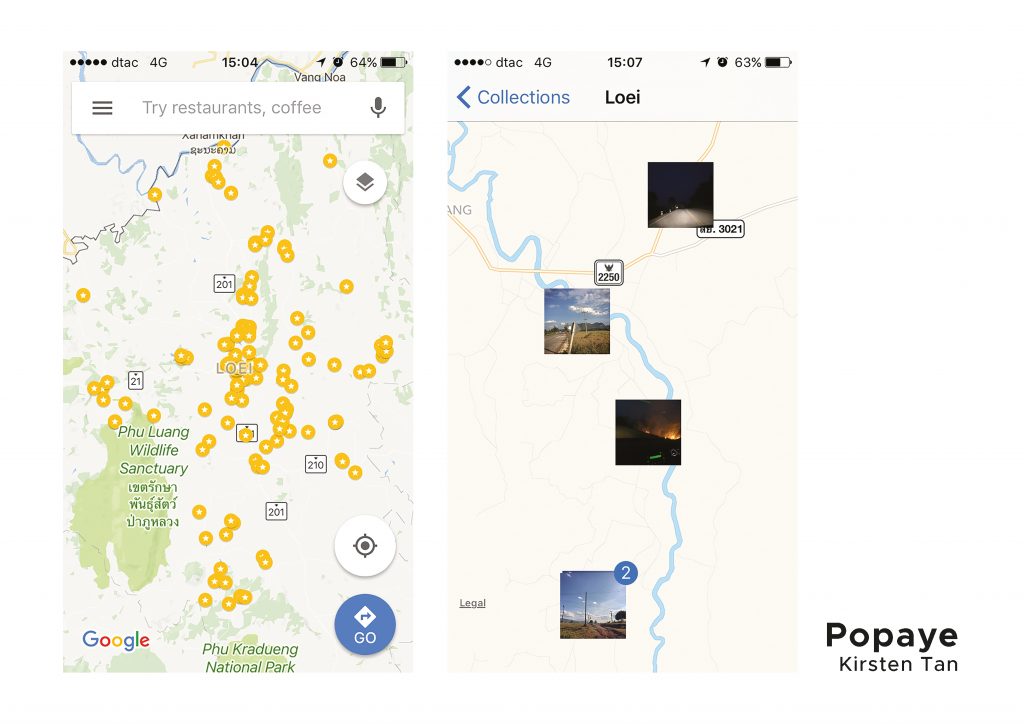
เรื่องถัดมาคือ ‘Pop Aye’ (2017) ซึ่งถือว่าเป็นหนังสเกลใหญ่กว่ามาก มีงบประมาณที่มากกว่า และที่สำคัญ สิ่งที่ผู้กำกับต้องการ (Kirsten Tan) ครั้งนี้คือภาพช้างเดินเพ่นพ่านในกรุงเทพฯ ซึ่งในความเป็นจริงมันไม่มีอะไรแบบนั้นอีกแล้ว “เราต้องหาชุดความจริงให้เขาด้วย ความเข้าใจของคนพอพูดถึงช้างคือต้องเป็นจังหวัดสุรินทร์หรือเชียงใหม่เท่านั้น แต่ด้วยเงื่อนไขด้านค่าใช้จ่าย เชียงใหม่เป็นไปไม่ได้แน่ๆ เพราะมันแพง ส่วนสุรินทร์ก็ไม่ได้เพราะเมืองมันไม่มีภูเขา แต่ในบทมันมีภูเขา เราก็เลยต้องค้นคว้าว่าที่ไหนเคยมีช้าง และน่าจะมีพื้นที่ที่ทำงานได้บ้างจนไปเจอเข้ากับจังหวัดเลย”
Pop Aye เป็น road movie ดังนั้นสิ่งที่ต้องหาเป็นลำดับต่อมาก็คือ เส้นทางที่ตัวเอกและช้างจะต้องเดินจากกรุงเทพฯ ไปยังจังหวัดเลย ที่ก็แน่นอนว่าจะเถรตรงยึดเอาเส้นทางจริงคือเดินตามถนนมิตรภาพนั้นเป็นไปไม่ได้ เพราะฉากสองข้างทางไม่ตรงกับบท ในการหา location ของวิทิต เขาเลือกที่จะวางกล้อง DSLR ไว้บ้าน ใช้ Google Street View มาร์คจุดไว้คร่าวๆ ก่อน แล้วใช้ iPhone เครื่องเก่าเป็นเครื่องมือ ในการสแนปภาพต่างๆ ประกอบการพรีเซ้นต์งานต่อผู้กำกับ ซึ่งข้อดีของการถ่ายด้วย iPhone ก็คือมันสามารถจัดเก็บตำแหน่ง ถนนหนทาง ทุ่งนา บ่อน้ำ ฯลฯ ที่เขาเจอด้วย GPS “มันสนุกมากที่เราได้เดินทางออกไปข้างนอก แต่ที่ไม่สนุกคือการบริหารจัดการ” วิทิตบอกกับ art4d ว่าความไม่สนุกของการทำงานเป็น location manager คือการดีลกับชาวบ้าน เคลียร์กับเทศกิจและตำรวจ ปิดถนน รับแรงปะทะจากชาวบ้านที่เดือดร้อนจากการถ่าย ซึ่งทั้งหมดนี้อยู่ภายใต้ข้อจำกัดของเดดไลน์ และงบประมาณ
เรื่องต่อมาที่เขาทำคือ 10 Years Thailand (2018) ตอน PLANETARIUM โดยจุฬญาณนนท์ ศิริผล และ CATOPIA โดยวิศิษฏ์ ศาสนเที่ยง ความจริงแล้วมีรายละเอียดสนุกๆ อีกพอสมควรที่ตีพิมพ์ไม่ได้ ปัจจุบันสิ่งที่วิทิตกำลังทำ ชอบทำ และทำเงินได้ดี (อย่างไม่น่าเชื่อ) คือการเปิด Vacilando Bookshop ที่เกิดขึ้นจากความชอบดูงานภาพถ่ายของช่างภาพคนอื่นๆ ทั่วโลก และการออกสำรวจ location หนังแล้วเจอเข้ากับร้านหนังสือเก่าทั่วประเทศ เขาช้อนซื้อหนังสือหายากมาเรื่อยๆ จนมีสต็อกมากพอที่จะเปิดร้านหนังสือ วิทิตถือว่าเป็นมนุษย์ที่ทำงานอยู่ใน Process ของวงการภาพยนตร์มาตลอด แต่ในบางครั้ง Process ที่ว่านี้ก็นำมาสู่ผลงานส่วนตัวด้วยอย่างหนังสือภาพถ่ายชื่อ “LOEI” สมุดภาพบันทึกการทำงานหา location ตลอด 3 เดือนให้กับหนังเรื่อง Pop Aye นอกจากนั้น เขายังบอกกับเราอีกว่ายังอยากทำงานศิลปะอยู่ตลอดเวลา และมีแผนว่าจะเอาข้อมูลที่เก็บได้จากการลงพื้นที่มาทำงานศิลปะในอนาคตอีกด้วย

Withit Chanthamarit was born in a full-on bureaucratic family and spent his high school life as one of the top students at one of the country’s most prestigious schools, Triam Udom Suksa. As highly academic as the vibe was, this school is where Chanthamarit found a group of friends that got him interested in the art world.
“The guys I was close to were all working on their own short films. I was more of an activity kid and my GPA wasn’t that pretty so I ended up submitting my graphic design portfolio, just because my friends were. And we were all accepted into Bangkok University. I myself got into Communication Arts, majoring in advertising.” Chanthamarit was offered a 4-year scholarship and a sum of monthly allowance if he were to accept the spot. It wasn’t a hard decision to make considering how he would be able to free his parents from the financial burdens his college life would have otherwise brought. “My friends were very determined about what they wanted to do. They already watched Joey’s (Apichatpong Weerasethakul) movies and I was just enjoying the Harry Potter saga. But I’ve always like photography books. I would browse through Thailand Tourism Promotion Organizations (now Thailand Tourism Authority) magazines and thought how great it would be to be a photographer and to travel to so many places.”
But ‘photography’ for him at the time was nowhere near the realm of art (or traveling for that matter). It was all studio work, carrying equipment, setting up lights, hearing the seemingly endless sounds of the flash going off. He spent the last semester of his university life working as an assistant photographer and his first fresh graduate year helping around the studio, getting paid by jobs and making a living by being a graduation photographer.
When the time came, Chanthamarit quit the studio (at one point, he was taking the role as the project manager). The big turning point was the big flood that hit Bangkok in 2011. “I began to realize that I’d actually never been anywhere. With all the gigs canceled due to the flood, I had a chance to meet with Miti Ruangkritya. We actually met through Flickr. There were a bunch of folks on Flickr who would go out and photograph the flooded city at night, and I sort of tagged along.”
Chanthamarit captured the image of his own home after the flood went down (Goin Home, 2011). It was right then when he was starting to see other possible aspects of photography other than its commercial use. After the flood was over, he was called back to the office and helped with a project—an ad promoting support for the flood victims. It was his last job before he took a turn to walk on the path towards the art world. He joined Toom Fab, an artist in residence at Nong Khai province, with a group of artists and curators. “I didn’t have any artistic processes of my own, and they were telling me to try to tell whatever I was feeling. When I returned, I got to work as a behind-the-scenes photographer for the film, 36 by Nawapol Thamrongrattanarit. I think I was standing with one of my feet in filmmaking and the other in art,” Chanthamarit told art4d.
“Angkor Photo Festival was the turning point that really gave me a clearer answer to what photography really is to me. I remember sitting in the class until 9 pm, feeling utterly confused. Someone came up to me and told me that there was no point sitting there, feeling lost, just go out and take some photos and we would talk about it tomorrow. So, I did. I went out in Siem Reap and took some photos.” That ‘going out’ ended up giving birth to ‘The wanderer’ (2012) series. The talk that ensued that day gradually led Chanthamarit to understand himself more and he realized how he had never actually taken himself anywhere outside of Bangkok. His life took place mostly in the rather shoddy suburban Lak Si neighborhood where he would go to school, come home, and was barely allowed to take a walk since his concerned parents were afraid that he would get mugged. “Photography has taken me out more.”
“Since Siem Reap, I spent a greater amount of time out of the house. I was out observing the PDP’s (People’s Democratic Reform Committee) demonstration at Lak Si. It was scary. Being there, I saw how everything worked, and who instigated the situation.” He submitted his ‘Transplantation’ (2014) series for Noorderlicht Photofestival in the Netherlands. The documentary photography series captured the lives of the protesters in different urban public spaces, questioning how the most absurd scenarios (such as a bunker built in front of McDonald’s) are being normalized and were becoming a part of Thai people’s daily life.
Chanthamarit later explains his mentioning of standing on in both the realm of film-making and art as something that has derived from what he needs in order to making a living. Creating art requires a considerable amount of money. Living another life as a behind-the-scene staff, or a part of the film-making process, from a still photographer to the cinematographer of the documentary, ‘Infected Tide’ by Nontawat Numbenchapol in 2013 to his role as the location manager for Prabda Yoon’s film ‘Motel Mist’ in 2016.
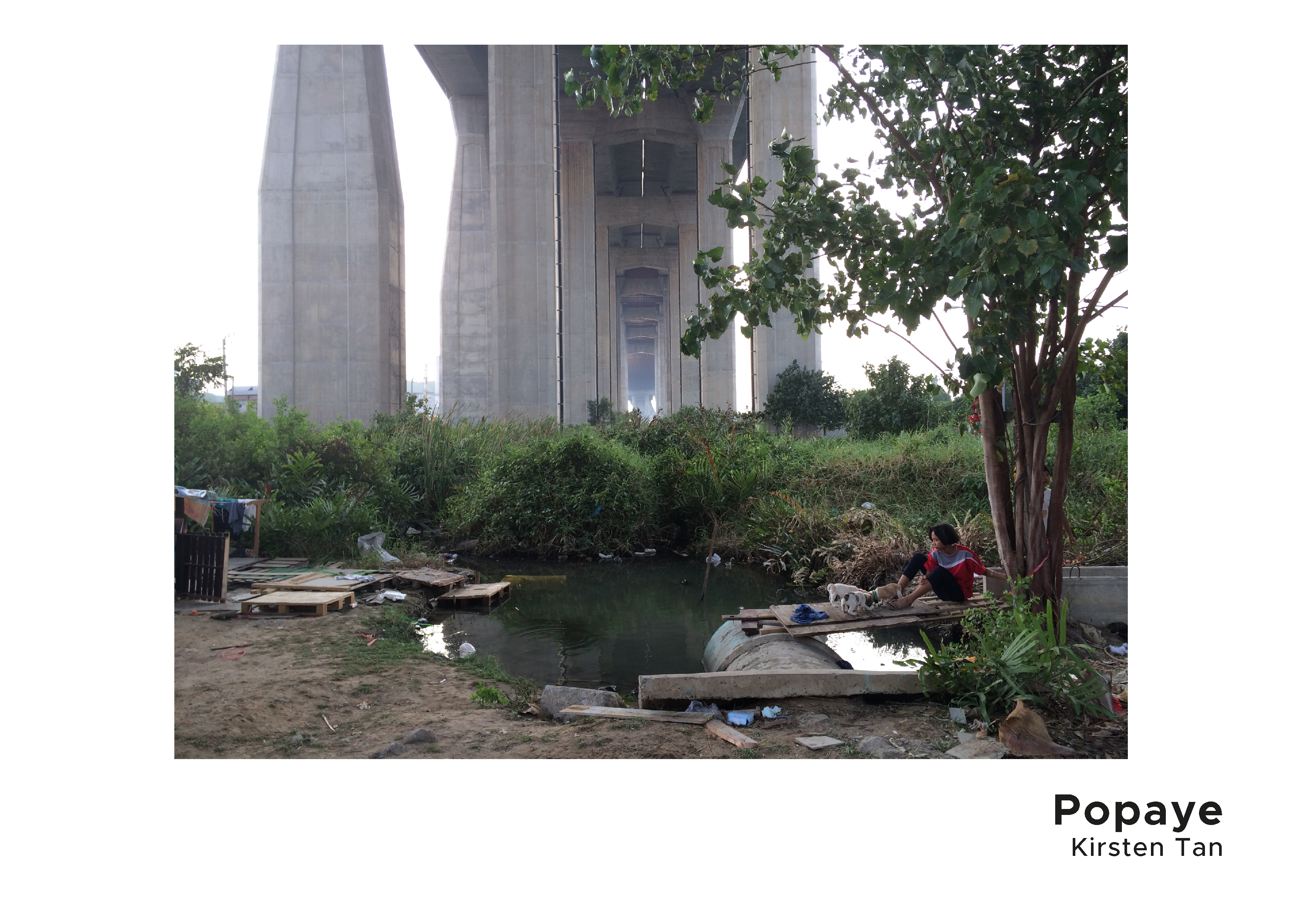
“He said that I should be able to handle the location management because I could envision the scenes and I have enough management skills.” The experience working in project management in studios suddenly came in handy. Chanthamarit told art4d that one of the tasks for his first film, as the location manager, was to find a drive-in love motel. It was different considering he was practically inexperienced in location scouting. He searched on webboards and stumbled upon a list of drive-in love motels throughout Bangkok. “The approach I took was like, ‘My brother was getting married, and we need to throw him a party, would you mind if I take a look at the space.’” Another trick was to go in with a female staff and ask to see the rooms. He finally discovered a large drive-in love motel (approximately 100 rooms) in a suburban area of Bangkok. “I made an offer to rent two of their floors to shoot a film with a promise that we wouldn’t bother their guests, so they agreed.”

His next project was ‘Pop Aye’ (2017), a film of a much bigger scale and bigger budget. The challenge that came with the project was the director’s (Kirsten Tan) demand for an image of elephants roaming the streets of Bangkok, despite that being somewhat far from the current reality. “I had to provide them the right set of reality. In most people’s understanding, when they think of elephants, they think of places like Surin or Chiang Mai, but with the limited budget, Chiang Mai was out of the question because the cost would be too high. Surin wouldn’t fit, too, because the screenplay specifically said the set is a mountainous town, I did some research to find whether there would be a location where there was a community of elephant mahouts with the landscape we were looking for. Finally, we settled on Loei.”
Pop Aye is a road movie, which means that the next thing he would have find was the route that the protagonist and the elephant took to travel on foot from Bangkok to Loei. Certainly, using the main highway like Mittraphap Road was almost impossible since the setting in the screenplay was nothing near to how the highway was looking. When doing location scouting, Chanthamarit would leave his DSLR camera at home and look at Google Street to help mark the points before using his old iPhone as a tool where he would snap pictures that would later be used for the presentation with the director. The upside of the iPhone is that it is able to record the locations, streets, fields, ponds, etc. that he came across along the way. “It’s very fun to be able to go out and travel. But the management wasn’t so fun, though.” For Chanthamarit, what’s tiring about his role as the location manager is having to deal with the locals, the authorities, and police when there’s a need to close a road, handling people when the shooting affects their lives. Everything has to be done within a limited time and cost.
The next projects he was a part of were the ‘PLANETARIUM’ episode by Chulayarnnon Siriphol and ‘CATOPIA’ episode by Wisit Sasanatieng of the ‘Ten Years Thailand’ (2018) anthology film, with some fun stories and tidbits which, unfortunately, cannot be published here. What Chanthamarit is currently doing is not only something he likes but also makes surprisingly good money, it is his Vacilando Bookshop. The shop was conceived from his interest in works of other photographers from around the world. The location scouting has taken him to countless second-hand bookshops countrywide, as his collection of rare books continues to grow and eventually became big enough for Chanthamarit to open his own bookshop.
He considers himself as someone who has been working within the process of film industry, but such a process sometimes leads him to create his own personal projects such as the book of photography titled ‘LOEI,’ which documents the three months period he spent scouting locations for the movie ‘Pop Aye.’ He didn’t forget to mention his restless artistic drive and his plan for using the information and experiences he had from location scouting to create his own artwork in the future.

